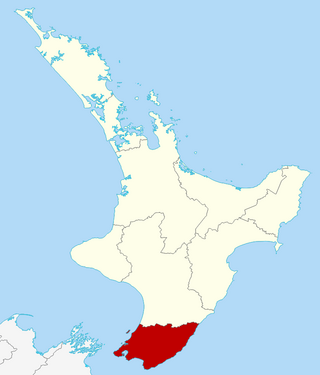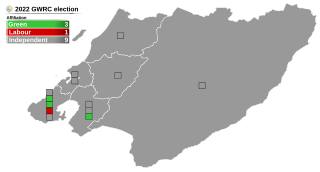
Greater Wellington, also known as the Wellington Region, is a non-unitary region of New Zealand that occupies the southernmost part of the North Island. The region covers an area of 8,049 square kilometres (3,108 sq mi), and has a population of 550,500.

Pahiatua is a rural service town in the south-eastern North Island of New Zealand with a population of 2,840. It is between Masterton and Woodville on State Highway 2 and along the Wairarapa Line railway, 60 kilometres (37 mi) north of Masterton and 30 kilometres (19 mi) east of Palmerston North. It is usually regarded as being in the Northern Wairarapa. For local government purposes, since 1989 it has been in the Tararua District, which encompasses Eketāhuna, Pahiatua, Woodvillle, Dannevirke, Norsewood and the far east of the Manawatū-Whanganui region.

The Wairarapa, a geographical region of New Zealand, lies in the south-eastern corner of the North Island, east of metropolitan Wellington and south-west of the Hawke's Bay Region. It is lightly populated, having several rural service towns, with Masterton being the largest. It is named after its largest lake, Lake Wairarapa.

Carterton is a small town in the Wellington Region of New Zealand and the seat of the Carterton District. It lies in a farming area of the Wairarapa in New Zealand's North Island. It is located 14 km (8.7 mi) southwest of Masterton and 80 km (50 mi) northeast of Wellington. The town has a population of 5,960, out of a total district population of 10,250.

Masterton is a large town in the Greater Wellington Region of New Zealand that operates as the seat of the Masterton District. It is the largest town in the Wairarapa, a region separated from Wellington by the Remutaka ranges. It stands on the Waipoua stream between the Ruamāhunga and Waingawa Rivers – 100 kilometres north-east of Wellington and 39.4 kilometres south of Eketāhuna.

Featherston is a town in the South Wairarapa District, in the Wellington Region of New Zealand's North Island. It is at the eastern foothills of Remutaka Range close to the northern shore of Lake Wairarapa, 63 km (39 mi) north-east of central Wellington and 37 km (23 mi) south-west of Masterton.

The Wairarapa Line is a secondary railway line in the south-east of the North Island of New Zealand. The line runs for 172 kilometres (107 mi), connects the capital city Wellington with the Palmerston North - Gisborne Line at Woodville, via Lower Hutt, Upper Hutt and Masterton.

The Greytown Branch was a five-kilometre 3 ft 6 in branch line railway off the Wairarapa Line at Woodside in the Wairarapa district of New Zealand's North Island. It followed an almost straight course over flat terrain. There were no intermediate stations.
Hood Aerodrome is an aerodrome, located in Masterton, New Zealand, it is located 1 NM South West of the town centre in the suburb of Solway. The aerodrome was named after George Hood, a pioneer Masterton aviator who died trying to make the first Trans-Tasman crossing in 1928. The aerodrome is used extensively for general aviation flights, and has also been used for commercial flights, Air New Zealand stopped serving the airport from 5 February 2014. Two new airlines have looked at re-instating a service to Auckland using larger aircraft but the runway will need to be lengthened to 1400m and widened to 30m first before it can start.
Irene Ferguson is an artist best known for her portrait paintings. Ferguson was awarded the New Zealand Portraiture Award in 2008.

William Beetham was an English-born portrait painter, who painted mainly in the United Kingdom and New Zealand. He exhibited his paintings at the Royal Academy of Arts in London (1834–53) and painted in Hamburg, Copenhagen and at the court of the Tsar in Saint Petersburg. He emigrated to New Zealand in 1855 and became a significant figure as a colonist, pastoralist and portrait artist. He had a society clientele and received commissions to paint portraits of aristocrats and national leaders, including important Māori Rangatira chiefs. Beetham's paintings are in the permanent collection of the National Portrait Gallery, London and Museum of New Zealand Te Papa Tongarewa in Wellington. He was the founder and Chair of the New Zealand Academy of Fine Arts in 1882. Mezzotint prints of Beetham's drawings are in the permanent collection of the Science Museum, London Beetham's paintings and drawings have also sold at Bonhams auction house.
Memorial Park, also known as Trust House Memorial Park for sponsorship reasons and formerly as Cameron and Soldiers' Park, is a sports facility which is located in Masterton, Wellington region, New Zealand. The two main sports that are played on the ground are Rugby and Football. It has a capacity for 10,000 spectators.
Maude Burge was a New Zealand painter influenced by James Nairn. She spent time as an expatriate artist specifically in Europe. Burge was a painting companion of Frances Hodgkins who called Maude Burge a "charming changeable woman" in her published letters. They painted together at the Burge family home in St.Tropez and in Ibiza. Burge's paintings are held in the permanent collection of Auckland Art Gallery, the Museum of New Zealand Te Papa Tongarewa, the National Art Gallery of New Zealand, the Fletcher Trust Collection, the National Library of New Zealand and among private art collectors in the northern and southern hemispheres. Burge exhibited her paintings at the New Zealand Academy of Fine Arts.

The Mataaho Collective is a group of four New Zealand artists: Erena Baker, Sarah Hudson, Bridget Reweti and Terri Te Tau. They are known for their large scale fibre-based artwork. In 2024 the Mataaho Collective received the Golden Lion award at the Venice Biennale.
Denis O'Connor is a New Zealand-based ceramicist, sculptor, and writer who has exhibited both in New Zealand and internationally.
Ian Ambury Miller Prior was a New Zealand doctor, epidemiologist, environmental campaigner and arts patron. He is acknowledged as the founder of epidemiology in New Zealand. He conducted pioneering epidemiological studies of Māori, Cook Islanders and Tokelau Islanders in the 1960s. He was active in a number of environmental campaigns including the International Physicians for the Prevention of Nuclear War, and was well known for his support of the arts, in particular the Wellington Sculpture Trust.

Hinehauone Coralie Cook, known as Corrie Cameron, was a New Zealand printmaker and watercolorist. Her works are held at New Zealand's National Museum Te Papa and in the National Library of New Zealand. She is regarded as being one of New Zealand's least recognised printmakers of the 1930s.

The 2022 Wellington Region local elections were held on 8 October 2022 as part of the wider 2022 New Zealand local elections to elect members to sub-national councils and boards. These elections covered one regional council, eight territorial authorities, and various community boards and licensing trusts.












